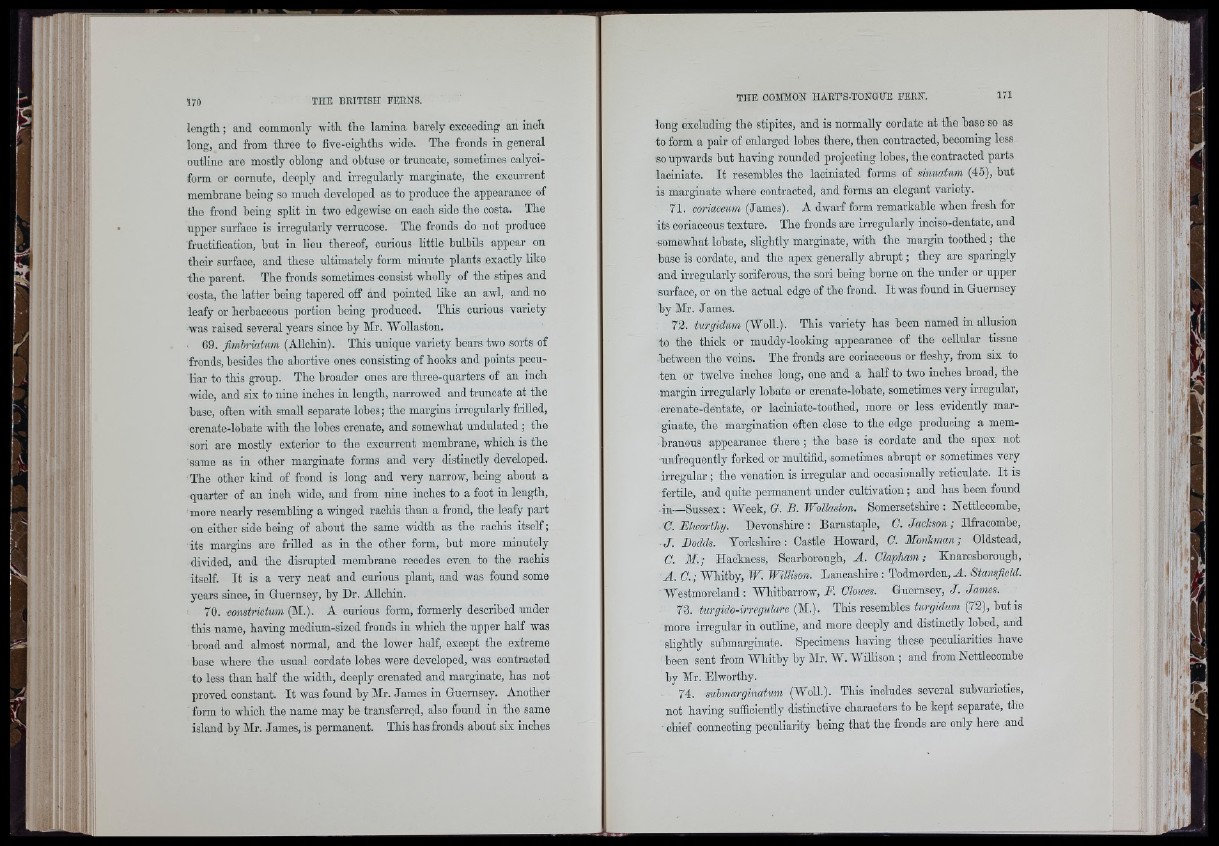
f í
i 4 ¡'¡ii í-S;
'■k:E
length; and commonly with the lamina barely exceeding an inch
long, and from three to five-eighths wide. The fronds in general
outline aro mostly oblong and obtuse or truncate, sometimes oalyci-
form or cornute, deeply and irregularly marginate, the oxcurrent
membrane being so much developed as to produce the appearance of
the frond hoing split in two edgewise on each side the oosta. The
upper surface is irregularly verrucose. The fronds do not produce
fruotifioation, hut in lion thereof, curious little bulbils appear on
their surface, and these ultimately form minute plants exactly like
the parent. The fronds sometimes consist wholly of the stipes and
costa, tho latter being tapered off and pointed like an awl, and no
leafy or herbaceous portion being produced. Tbis curious variety
was raised several years since by Mr. AVollaston.
69. fimbriatmn (Allchin). This unique variety hears two sorts of
fronds, besides the abortive ones consisting of hooks and points peculiar
to this group. The broader ones aro three-quarters of an inch
wide, and six to nine inches in length, narrowed and truncate at the
base, often with small separate lohes; the margins irregularly frilled,
orenate-lobate with the lobes crenate, and somewhat undulated ; the
sori are mostly exterior to the exourrent membrane, which is the
same as in other marginate forms and very distinctly developed.
The other kind of frond is long and very narrow, being about a
quarter of an inch wide, and from nine inches to a foot in length,
more nearly resembling a winged raohis than a frond, the leafy part
on either side being of about the same width as the rachis itself;
its margins are frilled as in the other form, but more minutely
divided, and the disrupted membrane recedes even to the raohis
itself. It is a very neat and curious plant, and was found some
years since, in Guernsey, by Dr. Allchin.
70. constrictum (M.). A curious form, formerly described under
this name, having medium-sized fronds in which the upper half was
broad and almost normal, and the lower half, except the extreme
base where the usual cordate lohes were developed, was contracted
to less than half the width, deeply crenated and marginate, has not
proved constant. It was found by Air. James in Guernsey. Another
form to which the name may be transferred, also found in the same
island by Air. James, is permanent. This has fronds about six inches
long excluding the stipites, and is normally cordate at the base so as
to form a pair of enlarged lobes there, then contracted, becoming less
so upwards but having rounded projecting lobes, the contracted parts
laoiniate. It resembles tbe laoiniated forms of sinuatum (45), but
is marginato where contracted, and forms an elegant variety.
71. coriaceum (James). A dwarf form remarkable when fresh for
its coriaceous texture. Tho fronds are irregularly inoiso-dentate, and
somewhat lobate, slightly marginato, with the margin toothed ; the
base is cordate, and the apex generally abrupt ; they are sparingly
and irregularly soriferous, the sori being borne on the under or upper
surface, or on the actual edge of the frond. It was found in Guernsey
by Mr. James.
72. turgidum (AVoll.). This variety has been named in allusion
to the thick or muddy-looking appearance of the cellular tissue
between tbe veins. Tbe fronds are coriaceous or fleshy, from six to
ten or twelve inches long, one and a half to two inches broad, the
margin irregularly lobate or orenate-lobate, sometimes very irregular,
crenate-dentate, or laoiniate-toothed, more or less evidently marginate,
the margination often close to the edge producing a membranous
appearance there ; the base is cordate and the apex not
unfrequently forked or multifid, sometimes abrupt or sometimes very
irregular ; the venation is irregular and occasionally reticulate. It is
fertile, and quite permanent under cultivation ; and has been found
in—Sussex: AVeek, Q. B. WoUaston. Somersetshire: Nettlecombe,
C. Elworthy. Devonshire : Barnstaple, C. Jackson ; Ilfraoombe,
J. Bodds. Yorkshire: Castle Howard, G. Monkman; Oldstead,
C. M.; Haokness, Scarborough, A. Clapham; Knaresborough,
A. C.; AVhitby, W. Willison. Lancashire : Todmorden, A. Stansfleld.
AVestmoreland; AVkitbarrow, F. Clowes. Guernsey, J. James.
73. turgido-irregulare (AI.). This resembles turgidum (72), bnt is
more irregular in outline, and more deeply and distinctly lobed, and
slightly submarginate. Specimens having these peculiarities have
been sent from AATiitby by Air. AV. AVilhson ; and from Nettlecombe
by Air. Elwortby.
74. submarginatum (AVoll.). This includes several subvarieties,
not having sufficiently distinctive characters to he kept separate, the
' chief conneoting peculiarity being that the fronds are only hero and
I!
'iM '
it;
i il - 1
ii!
'■ r i